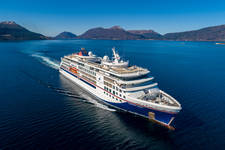The new ship can accommodate up to 230 guests, or 199 on Antarctic cruises and circumnavigations of Spitsbergen. The ship raises the bar in the expedition cruise segment and features many special structural elements that enhance further the expedition experience. The PC6 ice class, two extendible balconies, the Nature Walk deck tour at the ship’s bow, 17 on-board Zodiacs and E-Zodiacs with eco-friendly electric drive systems and a marina and on-board kayaks all enable passengers to enjoy intensive experiences of nature.
The HANSEATIC nature also features cutting-edge equipment and environmental technology. All three, new ships are fitted with an SCR catalytic converter, which reduces nitrogen oxide emissions by almost 95 %. The ships also have PROMAS rudders with special propellers and a special hull design to reduce fuel consumption and, therefore, lower emissions. Hapag-Lloyd Cruises has implemented a range of environmental protection measures, some of which go beyond the legal requirements. For example, the company does not use heavy oil in areas that require particular protection and uses low-pollutant marine gas oil on around 70 % of its expedition cruises. From July 2020, marine gas oil will be used on all routes for the entire expedition fleet. All new ships are equipped for cold ironing.
Between cruises to the Arctic in the European summer and expeditions to the Antarctic in the European winter, the HANSEATIC nature will also offer warmer water cruises to destinations such as the Amazon, the South Seas, Chile’s fjords, the Azores and Cape Verde. This allows passengers to visit remote, faraway places and embark on expeditions on the doorsteps of Europe.
Guests can discover fascinating information about the nature and environment of global expedition destinations not only on land but also on-board in innovative centres of knowledge. Experts will give daily presentations in the HanseAtrium, a separable multifunctional lounge with state-of-the-art technology and large LED screens on the walls and below the ceiling. On Deck 8, the heart of the Ocean Academy is the study wall, a 6 × 1.8 m (19 × 5.9 ft) touchscreen wall. Here guests can conduct individual studies and research to deepen their knowledge of the natural wonders they encounter on shore excursions and Zodiac rides. The content – provided by the GEOMAR Helmholtz Centre for Ocean Research in Kiel, as well as scientists, experts and journalists – is displayed, for example, in the form of articles, videos and biographies. The Ocean Academy also has four Study Seats, digital study posters and a microscope area.
“Inspired by nature”, the philosophy of the new expedition ships, has been brought to life by the OCEANARCHITECTS architectural office to reflect their expeditionary spirit. Nature is not only experienced outside but also is reflected in the ship’s interior design.
The 120 cabins and suites on the HANSEATIC nature range from Panoramic Cabins at 21 m2 (226 ft2) to Grand Suites at 71 m2 (764 ft2). There are exclusively outside cabins, almost all of which have their own balcony, or French balcony.
The Hamptons speciality restaurant has 44 seats and promises culinary diversity, serving North American specialities with the easy-going maritime flair of the East Coast. The expedition ship has two more restaurants: the HANSEATIC Restaurant (main restaurant) with 178 seats and the Lido Restaurant with 184 seats (indoor and outdoor), a barbecue and a show kitchen. Flexible mealtimes and free choice of seating in the restaurants ensure that guests can fit their meals around their expedition experiences, not the other way round.
The HANSEATIC nature has spacious wellness and fitness areas and a large pool area with a counter-current system.
Its sister ship, the HANSEATIC inspiration, will set sail this October. This will be the second new expedition ship from Hapag-Lloyd Cruises and all cruises will be conducted in both German and English.
Hamburg, May 2019


